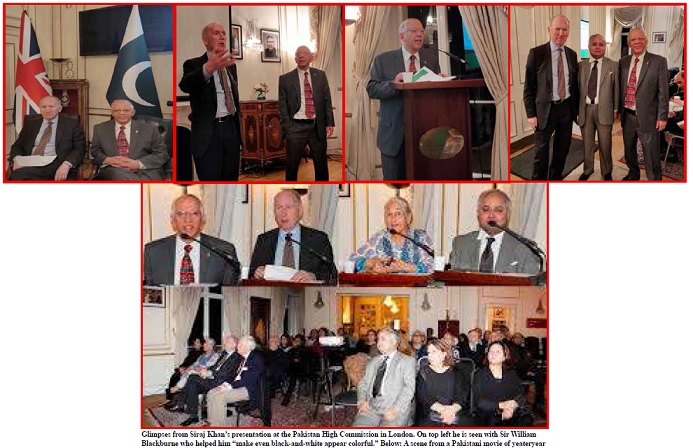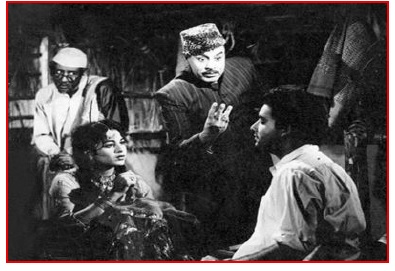Pakistan Cinema's Colorful Black-and-white Era - A Flashback
By Siraj Khan

On December 11, 2019 I had the distinct privilege and honor to be invited to give a presentation at the Pakistan High Commission, London. The topic was unusual, especially considering that not all the attending dignitaries and distinguished guests were Pakistanis. That my host and event moderator was Sir William Blackburne, the Queen’s Counsel, who serves as the High Court Judge and is also Treasurer of Lincoln’s Inn, was clearly my good fortune.
However, the story goes back earlier to May 2019. At a two-day conference held at the University of London titled India and Pakistan: The Formative Phase, 1947-1960, I had presented a paper Pakistan: Cinema Without Borders. There were many distinguished academics and historians present not only from Oxford, Cambridge and LSE, but also from Finland, Germany, Israel, India, USA and, of course, Pakistan. While the panelists spoke about the 1947 partition, Gandhi, Nehru, Jinnah, Lord Mountbatten, Radcliffe Line, etc. there I was standing up and speaking about Santosh Kumar, Darpan, Lala Sudhir, Noor Jahan, Sarfarosh, Intezar, Jago Hua Savera, etc. as part of Pakistan Cinema's black and white era. My topic and the content sounded quite amusing to me then, but my being invited again within just a few months to share my paper with a wider non-academic and non-scholastic audience, meant that surprisingly somewhere down the line, something may well have hit the right chord.
My presentation focused on the Pakistan cinema with a historical perspective and showcased the crucial role that it played in a developing society in Pakistan’s formative years, for the nation to emerge as an exemplary modern Islamic state. Films play a formative role in crystallizing a culture or addressing a contemporary issue, especially in an emerging landscape. In the first decade after its independence in August 1947, Pakistan too had multiple challenges staring at it, but it was also in these first 10-15 years, that its structure was cast into place. Being a composite art, cinema became responsible for popularizing music, dance and literature among the common people of Pakistan. In the process, films started to have almost a hypnotic influence on most adults and even children. To go to a cinema to watch films was to escape into a different world for a few hours, which made it easier to accept the hard realities of real life, at an affordable price.
By the end of the first 10 years of Pakistan’s formation, black-and-white cinema had become a powerful vehicle for culture, education, leisure and propaganda. Films of many genre, from documentary to drama were produced, which had a dramatic impact on lives in many tangible ways and are now excellent examples of the important role they have played on the social landscape in those years. Irrespective of the theme – whether joy, suspense, romance or social drama, entertainment was always the over-riding factor.

Hard to believe now, but by 1960 Pakistan had become the world's fourth largest producer of feature films, with films becoming an integral part of Pakistani culture – poised to enter the ‘golden age’ which was to follow (1961-1977). Perhaps, the most striking aspect of this development was that until TV made its entry in late 1964, except for Radio Pakistan for limited hours of music and a few weekly dramas (like Studio No 9, Hamid Mian ke Haan) in between the news, speeches and propaganda, Pakistan’s fledgling black-and-white cinema was the only source of family entertainment for the elite, middle class and the common man alike. It is no easy endeavor to change the psyche of the masses, amidst partition-related tribulations, while also keeping pace with state building and cross-border dynamics. These accomplishments should be recognized and not allowed to bury under the layers of time.
There were many films I wanted to project, but with time constraints, I selected the following 10 films, as part of my presentation.
1. 1948 - Do Ansoo
2. 1951 - Chanway
3. 1954 - Sassi
4. 1956 - Baghi
5. 1957 - Yakke Wali
6. 1958 - Anarkali
7. 1959 - Koel
8. 1959 - Kartar Singh
9. 1959 - Jago Hua Savera
10.1960 - Saheli
At the more recent talk at the High Commission on December 11, the Q&A turned out to be very vibrant and we overflowed into overtime and Sir Christopher Lee in Jinnah - The Movie somehow also got rolled in. The influence of music, songs and dances in the success (or failure) of the films was extensively discussed, as was the production of the 78 rpm records from the Gramophone Company of Pakistan Ltd. (indebted to Mr Rashid Latif Ansari). At times, I found it rather interesting talking of all this in the presence of an audience, which included many dignitaries and clearly many of those present were of British ethnicity.
In the end, however, it’s all about projecting Pakistan and somehow in the process of my crossing the pond, I felt that Pakistan, Britain and United States came together under the roof of the Pakistan High Commission, London.
I was truly humbled to play a tiny role in keeping the lamp alight and remain indebted to the Pakistan Society London to make it all happen. By a strange coincidence, the next day was Britain's General Election and I was not surprised to see the results. On the lighter side, while the Boris hairstyle is now "official" and here to stay as part of the new world order, it was perhaps unfair for many of my friends to blame me for "meddling" in Britain's elections.
In conclusion, I refer and reproduce a message I received from Anjum Taseer, son of Nauman Taseer, the producer of Jago Hua Savera who was also among the guests. I hope that somebody in the Government is also reading.
From: anjum taseer
To: Siraj Khan
Sent: Sun, Dec 15, 2019 5:52 am
Subject: Re: Dec 11 talk
Dear Siraj,
It was good to see you, as always, albeit for a very short visit!
Given the time constraint, you did exceedingly well - the subject was well covered and generated a lot of interest both in the show and outside; it is of course a pity that many films that you mentioned have not been projected and circulated worldwide, perhaps because there is no one from films owners/heirs to invest, try and find the films and restore them for posterity to enjoy. Maybe one needs to focus on this next.
Best,
Anjum
-----------------------------------------------------------------------------

